Effects of Rare Earth Elements on the Isothermal Oxidation of the Alumina-Scale-Forming NbSiTiAlHf Alloys
Abstract
1. Introduction
2. Materials and Methods
2.1. Sample Preparation
2.2. Thermal Treatment
2.3. Characterization Methods
3. Results and Discussion
3.1. The Microstructures of the NbSiTiAlHf Alloys After Vacuum Annealing
3.2. The Microstructures of the NbSiTiAlHf Alloys After Oxidation
3.2.1. The Surface Microstructure of the Oxide Scales
3.2.2. The Cross-Sectional Microstructure of the NbSiTiAlHf Alloys After Oxidation
3.3. The Oxidation Kinetics
3.4. The Growth of the Oxide Scales
4. Conclusions
- (1)
- The microstructures of the NbSiTiAlHf alloys consisted of the phases of Nb and Ti silicides, mainly identified as Nb3Si2, Ti5Si4, Nb3Si, and Ti5Si3, and the phases of Nb and Ti aluminides, mainly identified as (Nb,Ti)Al3. The phases of the alloys doped with different rare earth elements are almost the same as the undoped specimens. All of the alloys still exhibit the microstructural and compositional inhomogeneity after being annealed in a vacuum at 1300 °C for 24 h.
- (2)
- The whole scales are mainly composed of the major phases of Al2O3 and the minor phases of TiO2 (on the surface or in the upper layer of scales). The Al2O3 is most likely rich with small amounts of Si, whereas the TiO2 is rich with Nb and Hf. But, for the 0.5 at.% La-doped alloys, plenty of large voids with an average size of ~10 μm are observed in the oxide scale and near the scale/substrate interface. The major phases changed into Al2O3 and TiO2 from Al2O3 compared with other alloys. The other difference is that minor phases of Y2O3 and DyNbO4 are found on the surface or in the upper layer of scales for the alloys doped with Y and Dy, respectively. But, for the alloys doped with La, La-rich oxides are not detected on the scale surface.
- (3)
- The addition of Dy could effectively reduce the growth rate of oxide scale on the NbSiTiAlHf alloys. The parabolic rate constant of 0.5 at.% Dy-doped alloys has the lowest value, where the value decreases by 20% compared with the undoped alloys. The addition of La could deteriorate the oxidation resistance of the NbSiTiAlHf alloys, for which the parabolic rate constant of the 0.5 at.% La-doped alloys has the highest value, showing a six-fold and nineteen-fold increase over that of the Y-doped alloys and the undoped alloys, respectively. The benefits of Y on the oxidation rates were short-term ones, since there was a significant increase in the oxidation rates of the Y-doped alloys after 48h of oxidation compared with the undoped and Dy-doped alloys.
Author Contributions
Funding
Institutional Review Board Statement
Informed Consent Statement
Data Availability Statement
Conflicts of Interest
References
- Zheng, L.; Guo, H.B.; Guo, L.; Peng, H.; Gong, S.K.; Xu, H.B. New Generation Thermal Barrier Coatings for Ultrahigh Temperature Applications. J. Aeronaut. Mater. 2012, 32, 14–24. [Google Scholar]
- Guo, H.B.; Gong, S.K.; Xu, H.B. Research Progress on New High/ultra-high Temperature Thermal Barrier Coatings and Processing Technologies. Acta Aeronaut. Astronaut. Sin. 2014, 35, 2722–2732. [Google Scholar]
- Tsakiropoulos, P. Alloys for application at ultra-high temperatures: Nb-silicide in situ composites. Prog. Mater. Sci. 2022, 123, 100714. [Google Scholar] [CrossRef]
- Bewlay, B.P.; Jackson, M.R.; Subramanian, P.R.; Zhao, J.C. A review of very-high-temperature Nb-silicide-based composites. Metall. Mater. Trans. A 2003, 34, 2043–2052. [Google Scholar] [CrossRef]
- Tsakiropoulos, P. On Nb Silicide Based Alloys: Alloy Design and Selection. Materials 2018, 11, 844. [Google Scholar] [CrossRef]
- Gorr, B.; Schellert, S.; Müller, F.; Christ, H.-J.; Kauffmann, A.; Heilmaier, M. Current Status of Research on the Oxidation Behavior of Refractory High Entropy Alloys. Adv. Eng. Mater. 2021, 23, 2001047. [Google Scholar] [CrossRef]
- Sun, G.; Jia, L.; Ye, C.; Jin, Z.; Wang, Y.; Li, H.; Zhang, H. Balancing the fracture toughness and tensile strength by multiple additions of Zr and Y in Nb–Si based alloys. Intermetallics 2021, 133, 107172. [Google Scholar] [CrossRef]
- Su, L.; Jia, L.; Weng, J.; Hong, Z.; Zhou, C.; Zhang, H. Improvement in the oxidation resistance of Nb–Ti–Si–Cr–Al–Hf alloys containing alloyed Ge and B. Corros. Sci. 2014, 88, 460–465. [Google Scholar] [CrossRef]
- Sun, J.; Wang, Y.; Fu, Q. Thermal protections and silicide coatings on niobium alloy. Matreials China 2018, 37, 817–825. [Google Scholar]
- Zhang, P.; Guo, X. Improvement in oxidation resistance of silicide coating on an Nb–Ti–Si based ultrahigh temperature alloy by second aluminizing treatment. Corros. Sci. 2015, 91, 101–107. [Google Scholar] [CrossRef]
- Zhang, P.; Guo, X. Y and Al modified silicide coatings on an Nb–Ti–Si based ultrahigh temperature alloy prepared by pack cementation process. Surf. Coat. Technol. 2011, 206, 446–454. [Google Scholar] [CrossRef]
- Wen, S.H.; Zhou, C.G.; Sha, J.B. Microstructural evolution and oxidation behaviour of Mo-Si-B coatings on an Nb-16Si-22Ti-7Cr-2Al-2Hf alloy at 1250 °C prepared by spark plasma sintering. Surf. Coat. Technol. 2018, 352, 320–329. [Google Scholar] [CrossRef]
- Wang, W.; Yuan, B.; Zhuo, C. Formation and oxidation resistance of germanium modified silicide coating on Nb based in situ composites. Corros. Sci. 2014, 80, 164–168. [Google Scholar] [CrossRef]
- Hernández-Negrete, O.; Tsakiropoulos, P. On the Microstructure and Isothermal Oxidation at 800, 1200, and 1300 °C of the Al-25.5Nb-6Cr-0.5Hf (at %) Alloy. Materials 2019, 12, 2531. [Google Scholar] [CrossRef]
- Ghadyani, M.; Utton, C.; Tsakiropoulos, P. Microstructures and Isothermal Oxidation of the Alumina Scale Forming Nb1.7Si2.4Ti2.4Al3Hf0.5 and Nb1.3Si2.4Ti2.4Al3.5Hf0.4 Alloys. Materials 2019, 12, 222. [Google Scholar] [CrossRef]
- Ghadyani, M.; Utton, C.; Tsakiropoulos, P. Microstructures and Isothermal Oxidation of the Alumina Scale Forming Nb1.45Si2.7Ti2.25Al3.25Hf0.35 and Nb1.35Si2.3Ti2.3Al3.7Hf0.35 Alloys. Materials 2019, 12, 759. [Google Scholar] [CrossRef] [PubMed]
- Bao, Z.; Jiang, C.; Zhu, S.; Wang, F. High Temperature Protective Bond Coats: Development and Effect of Reactive Element. J. Aeronaut. Mater. 2018, 38, 21–31. [Google Scholar]
- Naumenko, D.; Pint, B.A.; Quadakkers, W.J. Current Thoughts on Reactive Element Effects in Alumina-Forming Systems: In Memory of John Stringer. Oxid. Met. 2016, 86, 1–43. [Google Scholar] [CrossRef]
- Li, D.; Guo, H.; Wang, D.; Zhang, T.; Gong, S.; Xu, H. Cyclic oxidation of β-NiAl with various reactive element dopants at 1200 °C. Corros. Sci. 2013, 66, 125–135. [Google Scholar] [CrossRef]
- Sun, Z.; Yin, M.; Zhao, C. Effects of Rare Earth Elements on Alloying and Anti-oxidation Coating Modification of Nb-Si Based Alloys. Foundry Technol. 2016, 37, 944–947. [Google Scholar]
- Li, Y.; Zhou, C. Co-deposition of Si-Cr-Y on Nb-Si in situ composites by the pack cementation process. Acta Mater. Compos. Sin. 2012, 29, 99–105. [Google Scholar]
- Yao, C.F.; Guo, X.P.; Guo, H.S.; Li, Y. Microstructure and Compositional Distribution in an Nb-Ti-Si-Cr-Hf-Al-B-Y Ultrahigh Temperature Alloy Ingot Prepared by Arc Melting. J. Mater. Eng. 2007, 35, 164–168. [Google Scholar]
- Ming, L.; Kang, Y.; Guo, F. Research progress in manufracturing technology in Nb-Si based ultra-high temperature structural materials. J. Mater. Eng. 2020, 48, 58–67. [Google Scholar]
- Monceau, D.; Pieraggi, B. Determination of parabolic rate constants from a local analysis of mass-gain curves. Oxid. Met. 1998, 50, 477–493. [Google Scholar] [CrossRef]
- Chen, W.; He, L.; Guo, Y.; Shan, X.; Li, J.; Guo, F.; Zhao, X.; Ni, N.; Xiao, P. Effects of reactive element oxides on the isothermal oxidation of β-NiAl coatings fabricated by spark plasma sintering. Surf. Coat. Technol. 2019, 357, 322–331. [Google Scholar] [CrossRef]
- Li, L.W.Z.; Yang, Y.; Liu, C.; Su, B.; Zhang, Q.; Li, Z.; Huang, J.; Wang, B.; Luo, L.; Chen, R.; et al. High temperature oxidation behavior of TiNbMoAlSi refractory high entropy alloy developed by electron beam additive manufacturing. J. Mater. Sci. Technol. 2025, 215, 131–146. [Google Scholar] [CrossRef]
- Guo, Y.L.; Jia, L.N.; Zhang, H.R.; Zhang, F.X.; Zhang, H. Enhancing the oxidation resistance of Nb-Si based alloys by yttrium addition. Intermetallics 2018, 101, 165–172. [Google Scholar] [CrossRef]
- Guo, Y.L.; Jia, L.N.; Zhang, H.R.; Kong, B.; Huang, Y.L.; Zhang, H. Microstructure and High-Temperature Oxidation Behavior of Dy-Doped Nb-Si-Based Alloys. Acta Met. Sin. 2018, 31, 742–752. [Google Scholar] [CrossRef]
- Yang, G.; Bai, W.; Han, S.; Wang, Y.; Cheng, L.; Zuo, J.; Kim, S.-W. An enhanced oxidation resistance in Ti-40Al-8Nb alloys with submicron (ω0+γ) microstructure: A comparative study. Corros. Sci. 2023, 213, 110989. [Google Scholar] [CrossRef]
- Lu, W.; Chen, C.L.; He, L.L.; Wang, F.H.; Lin, J.P.; Chen, G.L. (S)TEM study of different stages of Ti–45Al–8Nb–0.2W–0.2B–0.02Y alloy oxidation at 900 °C. Corros. Sci. 2008, 50, 978–988. [Google Scholar] [CrossRef]
- Pint, B.A. Experimental observations in support of the dynamic-segregation theory to explain the reactive-element effect. Oxid. Met. 1996, 45, 1–37. [Google Scholar] [CrossRef]
- Pint, B.A.; Hobbs, L.W. The formation of β-Al2O3 scales at 1500 C. Oxid. Met. 1994, 41, 203–233. [Google Scholar] [CrossRef]
- Michels, H.T. The effect of dispersed reactive metal oxides on the oxidation resistance of nickel-20 Wt pct chromium alloys. Metall. Trans. A 1976, 7, 379–388. [Google Scholar] [CrossRef]
- Pint, B.A. The Oxidation Behavior of Oxide-Dispersed β-NiAl: I. Short-Term Performance at 1200 °C. Oxid. Met. 1998, 49, 531–559. [Google Scholar] [CrossRef]
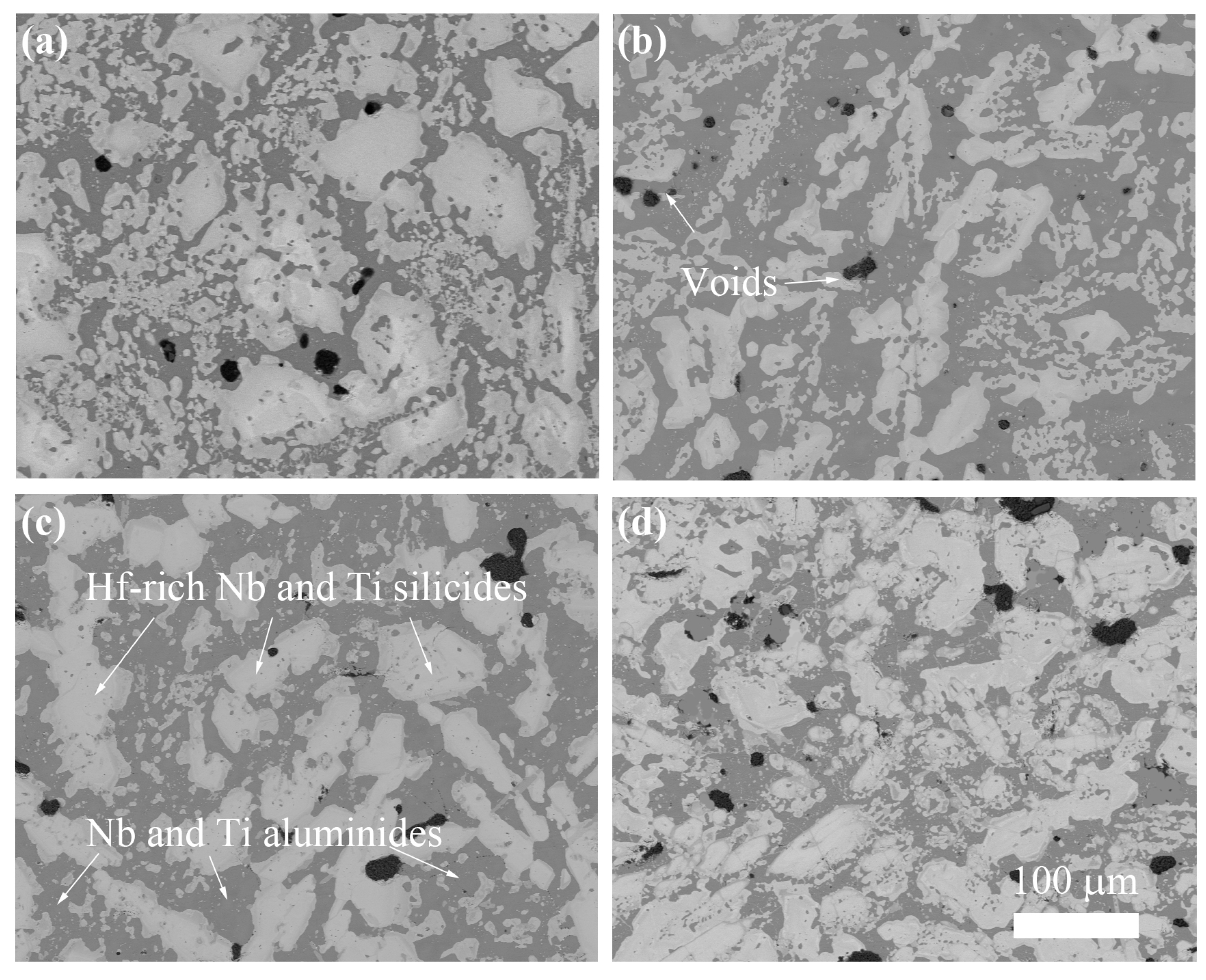
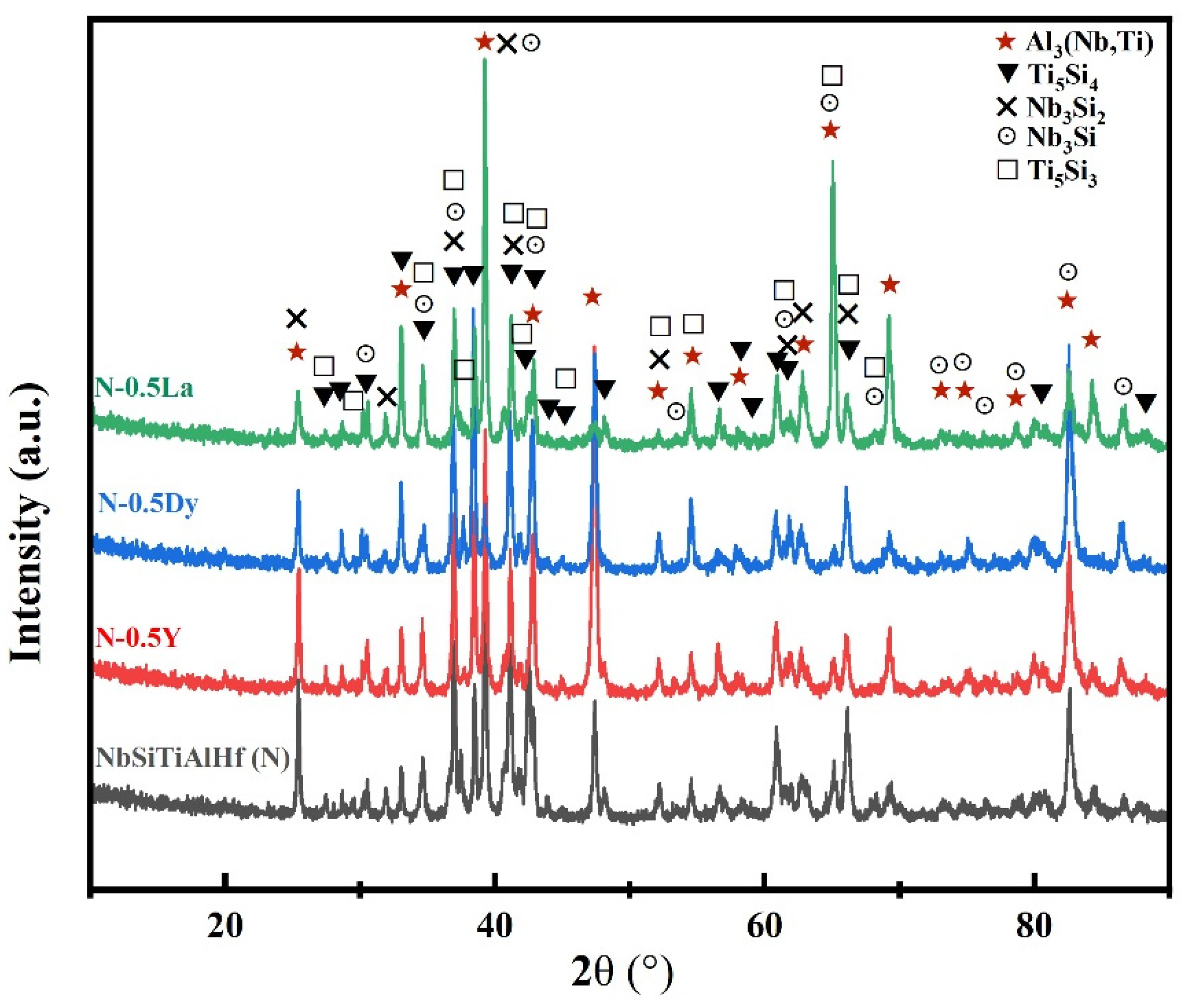

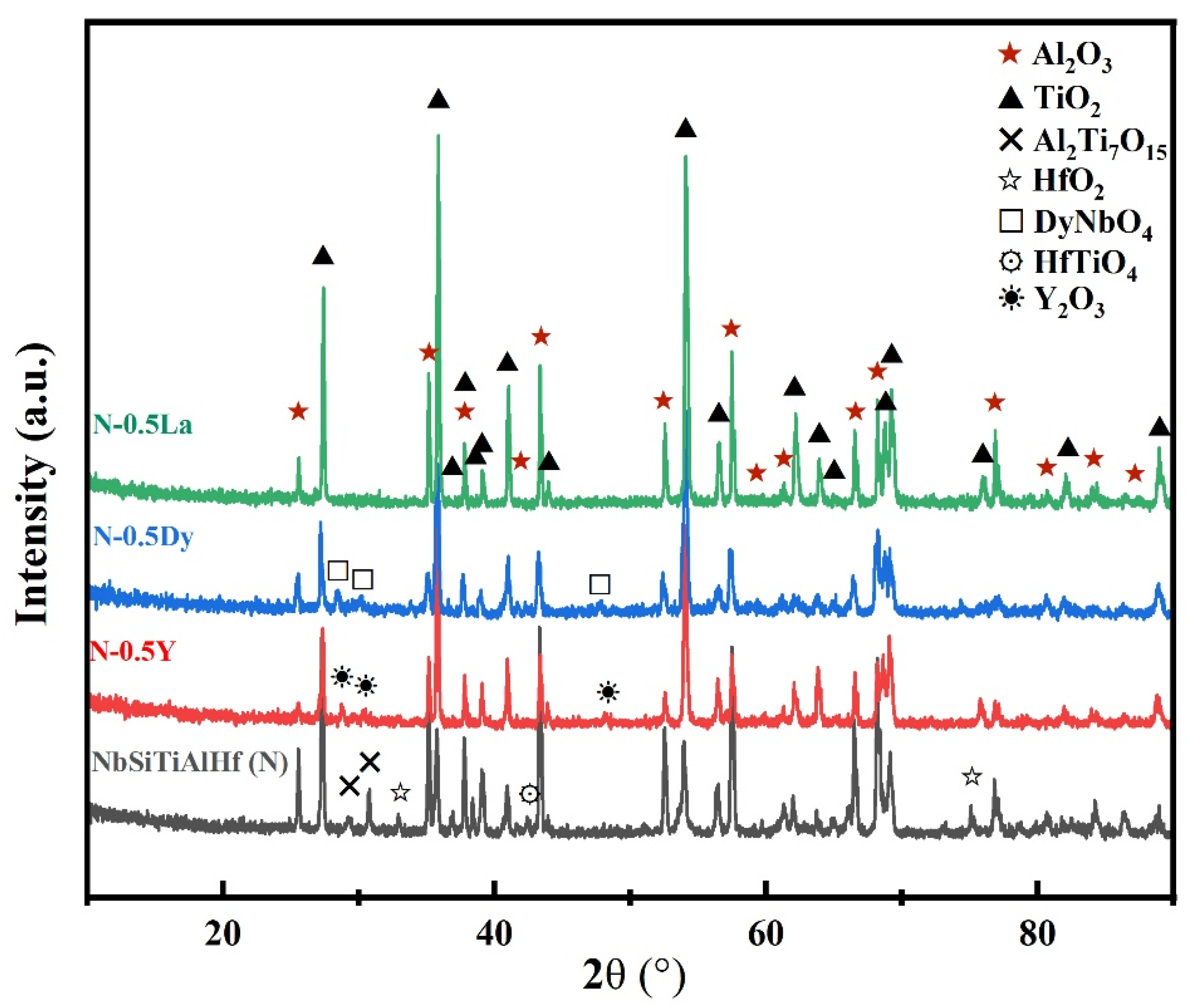

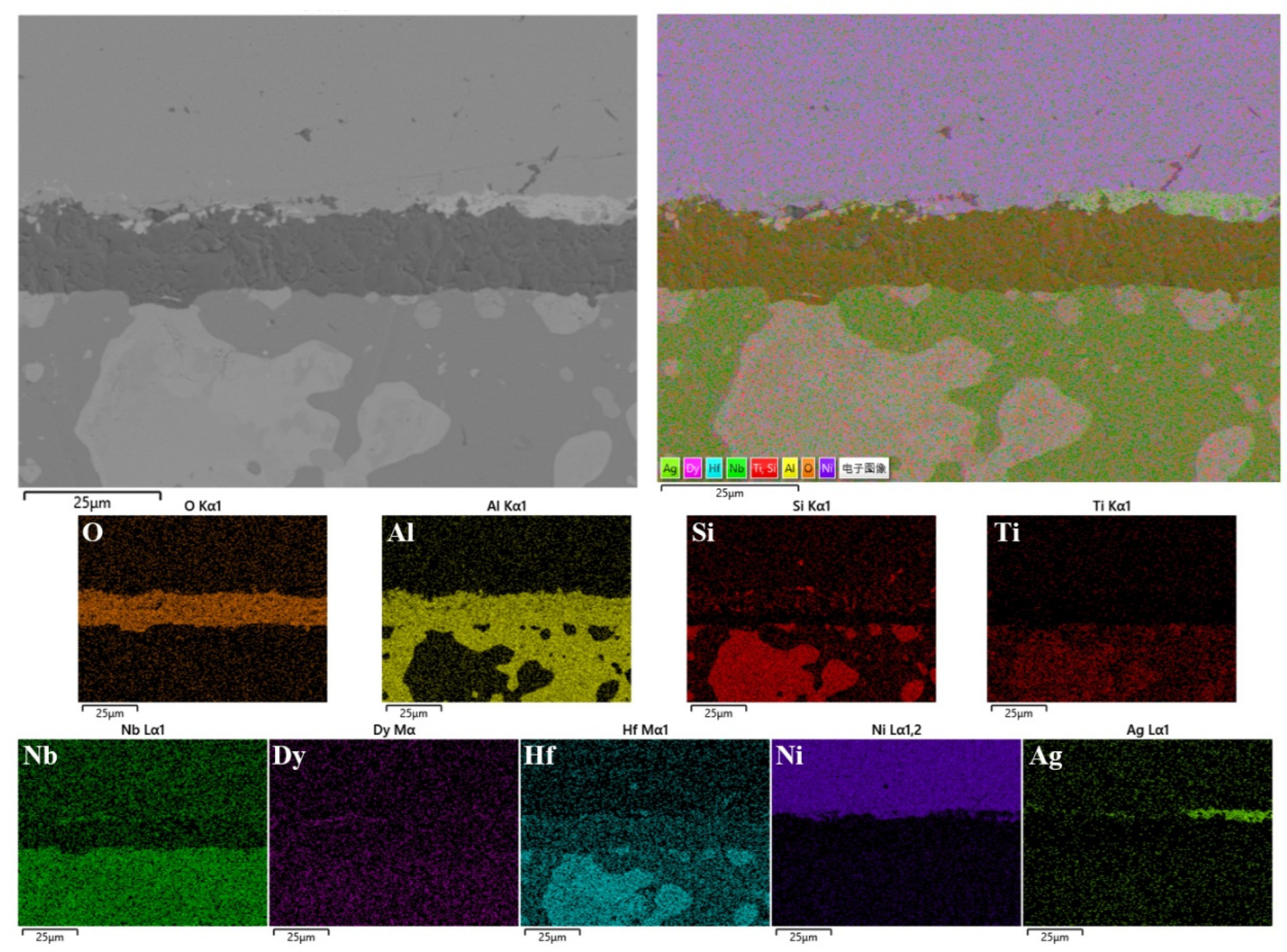
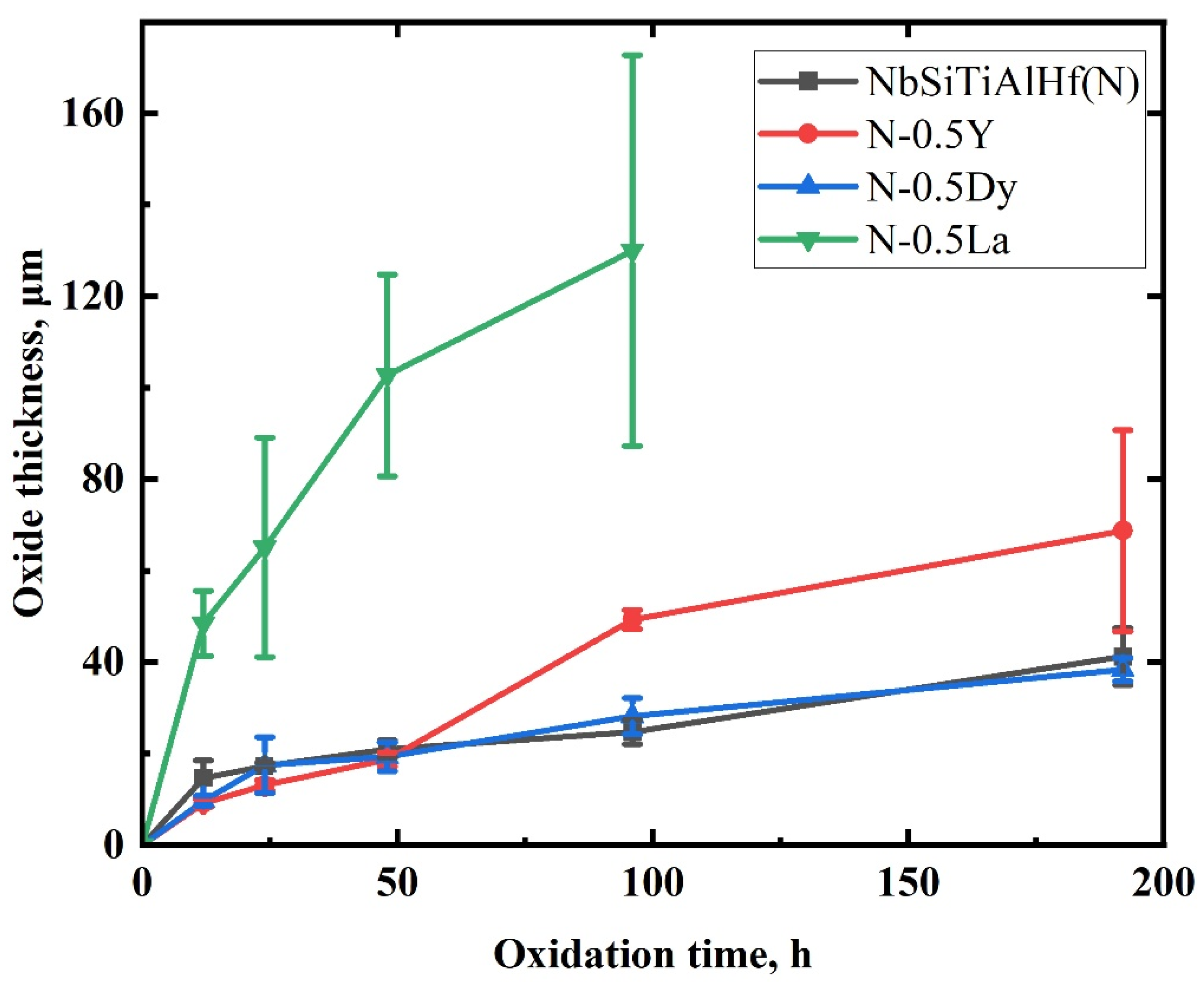
| Composition (at.%) | Kp (cm2/s) | Time (h) |
|---|---|---|
| NbSiTiAlHf (N) | 2.38 × 10−11 | 192 |
| N-0.5Y | 1.41 × 10−10 | 192 |
| N-0.5Dy | 1.87 × 10−11 | 192 |
| N-0.5La | 4.55 × 10−10 | 96 |
Disclaimer/Publisher’s Note: The statements, opinions and data contained in all publications are solely those of the individual author(s) and contributor(s) and not of MDPI and/or the editor(s). MDPI and/or the editor(s) disclaim responsibility for any injury to people or property resulting from any ideas, methods, instructions or products referred to in the content. |
© 2025 by the authors. Licensee MDPI, Basel, Switzerland. This article is an open access article distributed under the terms and conditions of the Creative Commons Attribution (CC BY) license (https://creativecommons.org/licenses/by/4.0/).
Share and Cite
Jiang, C.; Zhao, H.; Wu, D.; Zen, S.; He, Y.; Yang, X.; Zhang, L.; Yu, J.; Lu, L.; Chen, W. Effects of Rare Earth Elements on the Isothermal Oxidation of the Alumina-Scale-Forming NbSiTiAlHf Alloys. Materials 2025, 18, 5182. https://doi.org/10.3390/ma18225182
Jiang C, Zhao H, Wu D, Zen S, He Y, Yang X, Zhang L, Yu J, Lu L, Chen W. Effects of Rare Earth Elements on the Isothermal Oxidation of the Alumina-Scale-Forming NbSiTiAlHf Alloys. Materials. 2025; 18(22):5182. https://doi.org/10.3390/ma18225182
Chicago/Turabian StyleJiang, Chang, Hui Zhao, Dan Wu, Song Zen, Youxing He, Xuebin Yang, Linwei Zhang, Jiuming Yu, Lei Lu, and Wenfu Chen. 2025. "Effects of Rare Earth Elements on the Isothermal Oxidation of the Alumina-Scale-Forming NbSiTiAlHf Alloys" Materials 18, no. 22: 5182. https://doi.org/10.3390/ma18225182
APA StyleJiang, C., Zhao, H., Wu, D., Zen, S., He, Y., Yang, X., Zhang, L., Yu, J., Lu, L., & Chen, W. (2025). Effects of Rare Earth Elements on the Isothermal Oxidation of the Alumina-Scale-Forming NbSiTiAlHf Alloys. Materials, 18(22), 5182. https://doi.org/10.3390/ma18225182







